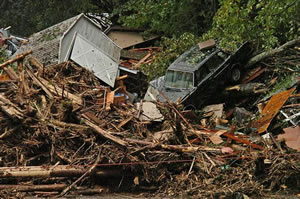July 9, 2018. An overview of 2018 state budget provisions affecting the environment:
♦ The budget provides funds to monitor water bodies for GenX and other per- and poly-fluoroalkyl substances (PFAS). The budget bill also gives the Governor a new authority to stop releases of PFAS albeit one not very practical to use. See an earlier post for a detailed description of the GenX budget provisions.
♦ The budget directs up to $2 million to Speedway Motor Sports for environmental remediation at Charlotte Motor Speedway. The state funding will need to be matched 2:1 by funding from other sources. Half of the revenue from N.C.’s solid waste disposal tax goes to assess and cleanup contamination associated with landfills that pre-dated 1983 environmental standards for waste disposal; one of these “pre-regulatory” landfills is located in the infield of Charlotte Motor Speedway. The law governing the remediation program requires DEQ to prioritize work on the old landfill sites based on risk to human health and the environment and it isn’t clear how the Charlotte Motor Speedway ranks under the priority factors. The budget provision may be intended to accelerate (sorry!) remediation of the Speedway landfill by immediately providing state funding, but conditioned on Speedway Motor Sports providing matching funds which is not normally required under the remediation program.
♦ The 2018 budget continues the legislature’s recent practice of bypassing the infrastructure grant program in DEQ to direct water and sewer funds to specific projects. In the normal grant process, DEQ and the State Water Infrastructure Authority allocate infrastructure funds under priority criteria that take into consideration a number of environmental, public health and financial factors. The budget bill diverts $2.5 million from the competitive grant program to projects in the towns of Richlands, Mount Airy, Bath and Trenton. The amount per project varies from $201,000 to over $1 million.
♦ The budget directs $5 million dollars to Resource Institute, Inc. “to explore opportunities for the development and implementation of emerging techniques that can extend the useful life of beach nourishment projects”. Resource Institute, Inc., a Winston-Salem based non-profit, describes its mission as “[enhancement of] America’s natural resources by restoring streams, rivers and wetlands”. information on the Resource Institute’s website indicate the nonprofit largely assists in connecting restoration project sponsors with potential funding sources and planning assistance; the Institute does not appear to directly work on design and construction of restoration projects.
♦ The budget bill revisits a 2017 budget provision controlling use of funds from the U.S. Environmental Protection Agency’s (EPA) settlement of a Clean Air Act enforcement case against Volkswagen (VW). Under the consent agreement, N.C. could receive over $90 million for air quality projects. The 2017 state budget required legislative committee review of DEQ’s proposed plan for use of the money and legislative appropriation of the funds to DEQ through the state budget process. (As a practical matter, that means the legislature would have to act before DEQ could spend any funds designated for North Carolina by the national VW settlement trustee.) The 2018 budget bill adds more detail by directing the State Treasurer to hold the VW funds in a special account until appropriated by the legislature. The 2018 provision also adds a new sentence prohibiting DEQ from releasing any funds to a third party until the legislature has appropriated the money. It isn’t clear whether the new sentence requires an individual appropriation for each project (and recipient) under the plan or was simply intended to restate the general requirement for a lump sum appropriation to DEQ through the state budget process. The difference could be significant since the national VW settlement trustee must be assured that DEQ has authority under state law to use the VW settlement funds for the purposes described in the state plan. Some environmental organizations have expressed concern that the provision may undermine N.C.’s eligibility to receive VW settlement funds if it is interpreted to mean the legislature could refuse funding to an intended recipient, undermining DEQ’s legal authority to carry out the plan.
♦ The General Assembly again delayed implementation of nutrient reduction rules in the Falls Lake and Jordan Lake watersheds; both lakes have impaired water quality due to excess nitrogen and phosphorus from wastewater discharges and runoff. The legislature has repeatedly postponed full enforcement of nutrient reduction rules adopted by the Environmental Management Commission in 2009 (Jordan Lake) and 2011 (Falls Lake). The 2018 budget provision adds at least another year to previous delays in implementation of the Jordan Lake rules; the suspended rules would remain in limbo until completion of a new rulemaking effort that may not begin until 2020. The provision extends the timeline for beginning work on new Falls Lake rules until 2024 and suspends enforcement of the later stages of the existing Falls Lake rules during that time. A number of previous posts — going back to 2013 — provide some history of legislative intervention in the regulation of nutrient discharges to the two reservoirs.
♦ Under the disaster relief section of the budget, the legislature provides $3.6 million to restart a program to map landslide hazard areas in western N.C. The legislature had defunded the landslide mapping program several years ago. (See an earlier post for background on the political death of the landslide mapping program.)


